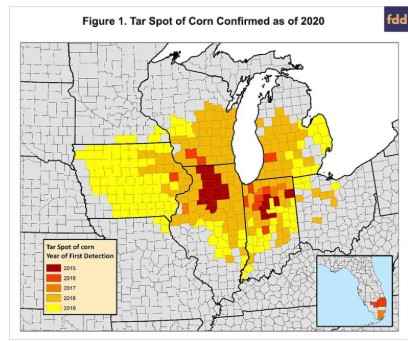By Nathan Kleczewski
Department of Crop Sciences
University of Illinois
It’s early in the season, but before we know it, corn will be chest high and we will be thinking about if in season management is needed. Last year I mentioned that you should “avoid the cosmic freakout” around tar spot. I again emphasize this statement this season. Tar spot is endemic to the state and region and it isn’t going anywhere any time soon. What sorts of things should you keep in mind this year when management is concerned?
1) Resistance. We do not have resistant hybrids that are commercially available. Dr. Tiffany Jamann’s lab from UIUC conducted a multi-state trial assessing several hundred exotic sources of resistance (and screened smaller subsets of highly diverse materials across several states and identified several promising sources of resistance). These results are being confirmed, and the genomes will be mapped. Hopefully by Fall we will have more information and tools to help screen materials for tar spot resistance. That being said, remember that currently no materials that are available are resistant to tar spot in the USA. Some hybrids are more tolerant than others. If your seed dealer has information on the relative tolerance of their hybrids to tar spot, and you are in an area where tar spot has been popping up over the past 5 years, try to select the hybrid with the most relative tolerance to tar spot. Remember, you still will get infection, but disease progress may be slower, and therefore yield impacts limited
2) Residue Management. Tar spot is residue borne, but also disperses on air currents. Although we do not know exactly how far the pathogen can spread from a source location, observations indicate that the disease likely travels at least several miles from a source. This limits the usefulness of residue management. A similar situation can be observed with Fusarium head blight in wheat, where residue management at the field level has a small impact on overall disease development, as under the correct conditions, the disease can be dispersed from neighboring fields and locations to other fields. Does this mean tillage and residue management won’t help with tar spot? Tillage will bury residue, but the type of tillage and amount of residue remaining likely impact the amount of inoculum or source strength of a particular field. Therefore, tillage could help reduce that source strength, but the impacts are likely to be variable and small, as nearby fields could provide inoculum. Later arrival of inoculum from distal sources could reduce overall amount of disease, but don’t expect to observe much of an impact under conditions that favor epidemics. The bottom line is that if you are practicing conservation tillage/no till, there isn’t a reason to return to conventional tillage systems.
Similarly crop rotation is unlikely to have much of an effect on tar spot. Many fields where corn was planted behind soybeans suffered just as much as corn on corn fields in the epidemic of 2018. Rotation still should be practiced to reduce the impact of more common (and significant) diseases such as grey leaf spot, northern corn leaf blight, and anthracnose.
3) Fungicides. There are many fungicides labeled for tar spot suppression. Fungicides can reduce tar spot. However, this disease ramps up reproduction and symptom/sign development rapidly. This means that timing of application is critical. Should you be making two sprays? Maybe under limited circumstances, but the likelihood of recovering your application + product costs under current commodity prices is low. A single application of a fungicide with mixed mode of action can be very effective. Shoot for the R1-R3 window, and remember, revenge sprays after the fact are not going to help you manage tar spot, although they may make you feel better in the short term.
4) Biologicals. There is a fungal hyperparasite that occurs quite frequently on those black spots (stroma) produced by the tar spot fungus. Much like this disease, we do not know much about this hyperparasite. However, given that it frequently occurs where the disease occurs, the likelihood that it has a significant impact is small.
5) Other items. Spacing and planting rate potentially may impact canopy closure and humidity in the canopy. In Mexico they also suggest to avoid excessive fertilization. Currently these aspects of management are being studied and hopefully we can get more information soon.
The last thing to remember is that this disease is heavily impacted by weather. Just because you had severe tar spot one season does NOT mean you are going to have it the following year. However, if you start to see the forecast calling for persistent rains heading into VT and you had it in previous seasons, you might need to consider a fungicide application.
Below is a map of where tar spot has been confirmed as of 2020. Because the disease in endemic, we will not be monitoring for the disease except in counties where it has been detected going forward. This is not a rust, and therefore continued annual mapping efforts are not especially useful for managing the disease. Imagine if we did that for grey leaf spot?

Thanks to FFAR, Pioneer, Wyffels Hybrids, and the national corn board for supporting the preliminary work that will help move research on this disease forward.
Source : illinois.edu